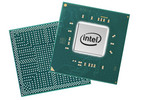
Geo Computers GeoFlex 140 2-in-1 laptop in test: A convertible for about $160
Intel Celeron N4020 | Intel UHD Graphics 600 | 14.10" | 2 kg

The Intel Celeron N4020 is a slow dual-core processor (SoC) of the Gemini Lake refresh product family; as such, it is designed for use in laptops and mini-PCs of the most affordable flavor. The Celeron was launched in Q4 2019. Its CPU cores run at 1.1 GHz to 2.8 GHz, the latter being a moderate 200 MHz upgrade over the preceding N4000 chip. Other key specs include a DDR4/LPDDR4 memory controller (up to 2,400 MHz and up to 8 GB, with independent reports claiming as much as 32 GB will work just fine) and an integrated UHD 600 graphics adapter.
Architecture & Features
Just like Apollo Lake family products, the ever-popular N3350 included, the N4020 is manufactured on a really old, as of late 2023, 14 nm process. What makes the newer Celerons different are the slightly improved processor cores with double the L2 cache and also, somewhat counterintuitively, a reduction in physical size.
The Goldmont Plus microarchitecture is not much different from what was used in Gemini Lake processors like the N4000. A relatively large 4 MB L2 cache features prominently on the rather short list of N4020's strong sides, allowing for a marginal increase in performance-per-MHz figures compared to processors of previous generations. Still, Gemini Lake refresh processors are a clear step down from Core i3/i5/i7/i9 series processors, both in performance and in features.
The N4020 has six PCI-Express 2.0 lanes at its disposal. While very few N4020-based SBCs, nettops and laptops feature an NVMe M.2 slot, you can use an NVMe SSD as a boot drive with this processor (read/write rates will be limited to 2 GB/s, though). Furthermore, partial Wi-Fi 5 support is built into the CPU. The Celeron also supports up to eight USB 3.0 ports and two SATA III storage devices.
Please note this is not a user-replaceable CPU. They solder it straight to the motherboard for good (BGA1090 socket interface).
Performance
While slightly faster than the outgoing Celeron N4000, the average N4020 in our extensive database only just manages to match the N6211, as far as multi-thread performance is concerned. These three chips deliver multi-thread CB R15, CB R20 and CB R23 scores that are so low, they lag behind a single-thread score of any half-decent CPU such as an i5-1135G7. In other words, these Celeron N chips are good enough for basic tasks only such as word processing and Web browsing with two or three tabs open at a time.
The Celeron N4120, a quad-core chip with a similar name, has little trouble leaving the N4020 behind in most workloads - which is not to say it is a fast CPU.
Jacking the long-term power limit value up to something like 9 W will help improve system responsiveness noticeably.
Graphics
The UHD Graphics 600 is based on Intel's Generation 9 architecture, much like the HD Graphics 520 or the UHD Graphics 615 or other widespread Intel iGPUs found in Core i3/i5/i7/i9 processors of generations six to ten.
Just like the HD Graphics 500, the UHD Graphics 600 is DX12 compatible. The iGPU's 12 EUs can run at up to 650 MHz. The Iris Plus G7 iGPU that certain 10th Gen Ice Lake processors have packs 64 EUs, for reference. As a low-end solution, UHD Graphics 600 will let you play some seriously old titles, but that's about as far as its talents go.
Perhaps more importantly, this graphics solution can drive up to 3 monitors with resolutions as high as 4096x2160@60. Furthermore, it will have no trouble HW-decoding AVC, HEVC and VP9-encoded videos. The newer AV1 codec will be decoded via software, with the limited CPU horsepower imposing a limit on video resolutions that can be played back without stuttering. 1080p60 videos are out of reach while 720p25 videos run fine, to give you an example.
Power consumption
The low 6 W TDP (also known as the long-term Power Limit) makes it easy for laptop makers to ditch the fan. Performance sustainability will be poor unless the long-term Power Limit is set to a value higher than the default 6 W and a fan is available to aid in heat dissipation.
The Celeron N4020 is built with one of the old 14 nm Intel processes for poor, as of mid 2023, energy efficiency.
| Codename | Gemini Lake refresh | ||||||||||||||||||||||||
| Series | Intel Gemini Lake | ||||||||||||||||||||||||
Series: Gemini Lake Gemini Lake refresh
| |||||||||||||||||||||||||
| Clock Rate | 1100 - 2800 MHz | ||||||||||||||||||||||||
| Level 2 Cache | 4 MB | ||||||||||||||||||||||||
| Number of Cores / Threads | 2 / 2 | ||||||||||||||||||||||||
| Power Consumption (TDP = Thermal Design Power) | 6 Watt | ||||||||||||||||||||||||
| TDP Turbo PL2 | 15 Watt | ||||||||||||||||||||||||
| Manufacturing Technology | 14 nm | ||||||||||||||||||||||||
| Socket | BGA1090 | ||||||||||||||||||||||||
| Features | DDR4-2400/LPDDR4-2400 RAM, PCIe 2, MMX, SSE, SSE2, SSE3, SSSE3, SSE4.1, SSE4.2, VMX, SMEP, SMAP, MPX, EIST, TM1, TM2, Turbo, AES-NI, RDRAND, RDSEED, SHA, SGX | ||||||||||||||||||||||||
| GPU | Intel UHD Graphics 600 (200 - 650 MHz) | ||||||||||||||||||||||||
| 64 Bit | 64 Bit support | ||||||||||||||||||||||||
| Architecture | x86 | ||||||||||||||||||||||||
| Announcement Date | 11/04/2019 | ||||||||||||||||||||||||
| Product Link (external) | ark.intel.com | ||||||||||||||||||||||||


Asus Chromebook C424MA: Intel UHD Graphics 600, 14.00", 1.5 kg
External Review » Asus Chromebook C424MA
Asus VivoBook 14 E410MA-EK1987WS: Intel UHD Graphics 600, 14.00", 1.3 kg
External Review » Asus VivoBook 14 E410MA-EK1987WS
Gateway GWNC21524-RD: Intel UHD Graphics 600, 15.60", 1.6 kg
External Review » Gateway GWNC21524-RD
Asus VivoBook 14 E410MA-EK007WS: Intel UHD Graphics 600, 14.00", 1.3 kg
External Review » Asus VivoBook 14 E410MA-EK007WS
HP ChromeBook 14a-na0014ns: Intel UHD Graphics 600, 14.00", 1.5 kg
External Review » HP ChromeBook 14a-na0014ns
HP 15s-fq0011ns: Intel UHD Graphics 600, 15.60", 1.7 kg
External Review » HP 15s-fq0011ns
Asus VivoBook 14 E410MA-EK007TS: Intel UHD Graphics 600, 14.00", 1.3 kg
External Review » Asus VivoBook 14 E410MA-EK007TS
HP Stream 14s-dq0009ns: Intel UHD Graphics 600, 14.00", 1.5 kg
External Review » HP Stream 14s-dq0009ns
HP Stream 14s-dq0014ns: Intel UHD Graphics 600, 14.00", 1.5 kg
External Review » HP Stream 14s-dq0014ns
HP Stream 14s-dq0008ns: Intel UHD Graphics 600, 14.00", 1.5 kg
External Review » HP Stream 14s-dq0008ns
Asus Chromebook Flip C214MA-BU0410: Intel UHD Graphics 600, 11.60", 1.2 kg
External Review » Asus Chromebook Flip C214MA-BU0410
HP Chromebook 14a-na0023nr: Intel UHD Graphics 600, 14.00", 1.5 kg
External Review » HP Chromebook 14a-na0023nr
Asus Chromebook CX1101: Intel UHD Graphics 600, 11.60", 1.2 kg
External Review » Asus Chromebook CX1101
Lenovo V14 IGL-82C2001QGE: Intel UHD Graphics 600, 14.00", 1.6 kg
External Review » Lenovo V14 IGL-82C2001QGE
HP Chromebook 14a-na0006ns: Intel UHD Graphics 600, 14.00", 1.5 kg
External Review » HP Chromebook 14a-na0006ns
HP Chromebook 11 G8 EE-1A762UT: Intel UHD Graphics 600, 11.60", 1.3 kg
External Review » HP Chromebook 11 G8 EE-1A762UT
HP Chromebook x360 14a-ca0003ns: Intel UHD Graphics 600, 14.00", 1.5 kg
External Review » HP Chromebook x360 14a-ca0003ns
HP Stream 14-dq0010nr: Intel UHD Graphics 600, 14.00", 1.5 kg
External Review » HP Stream 14-dq0010nr
HP Chromebook 14a-na0004ns: Intel UHD Graphics 600, 14.00", 1.5 kg
External Review » HP Chromebook 14a-na0004ns
HP Chromebook 14a-na0005ns: Intel UHD Graphics 600, 14.00", 1.5 kg
External Review » HP Chromebook 14a-na0005ns
Asus VivoBook 15 F515MA-BR040: Intel UHD Graphics 600, 15.60", 1.8 kg
External Review » Asus VivoBook 15 F515MA-BR040
HP Stream 11-ak0004ns: Intel UHD Graphics 600, 11.60", 1.1 kg
External Review » HP Stream 11-ak0004ns
Asus Chromebook Flip C214 C214MA-Q1R-CB: Intel UHD Graphics 600, 11.60", 1.2 kg
External Review » Asus Chromebook Flip C214 C214MA-Q1R-CB
Dynabook E10-S: Intel UHD Graphics 600, 11.60", 1.1 kg
External Review » Dynabook E10-S
Asus E510MA-EJ133T: Intel UHD Graphics 600, 15.60", 1.6 kg
External Review » Asus E510MA-EJ133T
Acer Spin 1 SP111-33-C690: Intel UHD Graphics 600, 11.60", 1.3 kg
External Review » Acer Spin 1 SP111-33-C690
HP Chromebook x360 12b-ca0001ns: Intel UHD Graphics 600, 12.00", 1.4 kg
External Review » HP Chromebook x360 12b-ca0001ns
Asus L410MA-DB02: Intel UHD Graphics 600, 14.00", 1.3 kg
External Review » Asus L410MA-DB02
Acer Chromebook 14 CB314-1H-C7PS: Intel UHD Graphics 600, 14.00", 1.5 kg
External Review » Acer Chromebook 14 CB314-1H-C7PS
HP Chromebook x360 14b-ca0001ns: Intel UHD Graphics 600, 14.00", 1.6 kg
External Review » HP Chromebook x360 14b-ca0001ns
Lenovo IdeaPad 3 15IGL05-81WQ002QGE: Intel UHD Graphics 600, 15.60", 1.7 kg
External Review » Lenovo IdeaPad 3 15IGL05-81WQ002QGE
Lenovo IdeaPad 1 14IGL05-81VU0079US: Intel UHD Graphics 600, 14.00", 1.4 kg
External Review » Lenovo IdeaPad 1 14IGL05-81VU0079US
Asus L510MA-DS04: Intel UHD Graphics 600, 15.60", 1.6 kg
External Review » Asus L510MA-DS04
Samsung Chromebook 4 XE310XBA-KA1US: Intel UHD Graphics 600, 11.60", 1.2 kg
External Review » Samsung Chromebook 4 XE310XBA-KA1US
Acer Aspire 1 A115-31-C2Y3: Intel UHD Graphics 600, 15.60", 1.9 kg
External Review » Acer Aspire 1 A115-31-C2Y3
Lenovo IdeaPad 1 11IGL05-81VT003ASP: Intel UHD Graphics 600, 11.60", 1.2 kg
External Review » Lenovo IdeaPad 1 11IGL05-81VT003ASP
Acer Chromebook Spin 511 R752T-C3M5: Intel UHD Graphics 600, 11.60", 1.3 kg
External Review » Acer Chromebook Spin 511 R752T-C3M5
Dell Chromebook 11 3100-0JWC5: Intel UHD Graphics 600, 11.60", 1.3 kg
External Review » Dell Chromebook 11 3100-0JWC5
HP Stream 11-ak0005ns: Intel UHD Graphics 600, 11.60"
External Review » HP Stream 11-ak0005ns
HP Stream 11-ak0003ns: Intel UHD Graphics 600, 11.60"
External Review » HP Stream 11-ak0003ns
HP Chromebook x360 14a-ca0102nd: Intel UHD Graphics 600, 14.00", 1.5 kg
External Review » HP Chromebook x360 14a-ca0102nd
HP 240 G8: Intel UHD Graphics 600, 14.00", 1.5 kg
External Review » HP 240 G8
Acer Chromebook 315 CB315-3H-C7JF: Intel UHD Graphics 600, 15.60", 1.7 kg
External Review » Acer Chromebook 315 CB315-3H-C7JF
Acer Chromebook 315 CB315-3H-C5JS: Intel UHD Graphics 600, 15.60", 1.6 kg
External Review » Acer Chromebook 315 CB315-3H-C5JS
Asus VivoBook 14 E410MA-EK018TS: Intel UHD Graphics 600, 14.00", 1.3 kg
External Review » Asus VivoBook 14 E410MA-EK018TS
Lenovo IdeaPad Flex 3 11IGL05: Intel UHD Graphics 600, 11.60", 1.1 kg
External Review » Lenovo IdeaPad Flex 3 11IGL05
Asus Vivobook 12 E210MA-GJ001TS: Intel UHD Graphics 600, 11.60", 1.1 kg
External Review » Asus Vivobook 12 E210MA-GJ001TS
Lenovo IdeaPad 3 14IGL05-81WH0000MJ: Intel UHD Graphics 600, 14.00", 1.5 kg
External Review » Lenovo IdeaPad 3 14IGL05-81WH0000MJ
Lenovo IdeaPad Duet 3 10IGL5-82AT002YSP: Intel UHD Graphics 600, 10.30", 0.9 kg
External Review » Lenovo IdeaPad Duet 3 10IGL5-82AT002YSP
Asus Vivobook 12 L210MA-GJ050TS: Intel UHD Graphics 600, 11.60", 1.1 kg
External Review » Asus Vivobook 12 L210MA-GJ050TS
Asus VivoBook 14 A416: Intel UHD Graphics 600, 14.00", 1.6 kg
External Review » Asus VivoBook 14 A416
Acer Chromebook 314 CB314-1H-C75Z: Intel UHD Graphics 600, 14.00", 1.5 kg
External Review » Acer Chromebook 314 CB314-1H-C75Z
Lenovo IdeaPad Duet 3 10IGL5-82AT002VGE: Intel UHD Graphics 600, 10.30", 0.6 kg
External Review » Lenovo IdeaPad Duet 3 10IGL5-82AT002VGE
Asus VivoBook 14 E410MA-EK367TS: Intel UHD Graphics 600, 14.00", 1.3 kg
External Review » Asus VivoBook 14 E410MA-EK367TS
Lenovo IdeaPad Flex 3 Chromebook 11IGL05: Intel UHD Graphics 600, 11.60", 1.2 kg
External Review » Lenovo IdeaPad Flex 3 Chromebook 11IGL05
Lenovo IdeaPad 3 CB 14IGL05-82C10004US: Intel UHD Graphics 600, 14.00", 1.4 kg
External Review » Lenovo IdeaPad 3 CB 14IGL05-82C10004US
Lenovo IdeaPad 3 11IGL05 (Chromebook 3 11): Intel UHD Graphics 600, 11.60", 1.1 kg
External Review » Lenovo IdeaPad 3 11IGL05
Acer Chromebook 314 CB314-1H-C0YY: Intel UHD Graphics 600, 14.00", 1.5 kg
External Review » Acer Chromebook 314 CB314-1H-C0YY
Lenovo IdeaPad Flex 3 11IGL05: Intel UHD Graphics 600, 11.60", 1.1 kg
» Despite the low price, the Lenovo IdeaPad Flex 3 is not a stunner
» Mobile CPU Comparison
Comparison of all mobile CPU series
» Mobile Processors - Benchmarklist
Benchmarklist of all known CPUs that are used in laptops (desktop and laptop CPUs)
Top 10 Laptops
Multimedia, Budget Multimedia, Gaming, Budget Gaming, Lightweight Gaming, Business, Budget Office, Workstation, Subnotebooks, Ultrabooks, Chromebooks
under 300 USD/Euros, under 500 USD/Euros, 1,000 USD/Euros, for University Students, Best Displays
Top 10 Smartphones
Smartphones, Phablets, ≤6-inch, Camera Smartphones